 salaam and heartfelt condolences to our readers on the beginning of the month of Moharram, the month of grief that moistens eyes. It is the month whose start is marked by the faithful in Iran, Iraq, Bahrain, Lebanon, the Republic of Azerbaijan, Yemen, India, Pakistan, Afghanistan, and wherever there are followers of the Ahl al-Bayt of Prophet Mohammad (SAWA), with black attires, black banners, and black draping as a mark of respect to the Immortal Martyr of Karbala, Imam Husain (AS).
salaam and heartfelt condolences to our readers on the beginning of the month of Moharram, the month of grief that moistens eyes. It is the month whose start is marked by the faithful in Iran, Iraq, Bahrain, Lebanon, the Republic of Azerbaijan, Yemen, India, Pakistan, Afghanistan, and wherever there are followers of the Ahl al-Bayt of Prophet Mohammad (SAWA), with black attires, black banners, and black draping as a mark of respect to the Immortal Martyr of Karbala, Imam Husain (AS).
It is unfortunate that in some countries, the first of Moharram is celebrated with pagan-like gaiety reminiscent of the pre-Islamic days of Abu Jahal and Abu Sufyan, without any inhibitions for the sufferings of the noble family of the Prophet in this month. It is an irony that the beginning of the Islamic lunar hijri calendar was fixed on the 1st of Moharram by the 2nd caliph, Omar Ibn Khattab, instead of the 1st of Rabi al-Awwal, the exact day of the Prophet’s hijra or migration from Mecca to Medina, a suggested by the Commander of the Faithful, Imam Ali Ibn Abi Taleb (AS).
The reason for this dubious choice was that since Moharram comes after the end of the Hajj rituals and is the last of the four sacred months of the year, and the 3rd in consecutive in a row, it was chosen as the first month of the lunar year. Anyway, for the faithful, the start of Moharram brings to memory the arrival of Imam Husain (AS) in Karbala and his tragic martyrdom on Ashura or the 10th of this month in defence of Islam and humanitarian values. Please stay with us for a special feature in this regard.
According to exegetes of the holy Qur’an, the four months of the year deemed sacred and dedicated to the worship of the One and Only God, starting with Rajab and ending with Moharram, is traced to the time of Prophet Abraham. This tradition remained in vogue even during the dark days of Jahiliyya when the Arabs had deviated from monotheism and took to the worship of idols. These constantly fighting tribes, considered the sacred months as haraam or forbidden for warfare, so that the people could have some respite before renewal of another round of fratricide. With the advent of Islam, the Abrahamic spirit of the sacred months was revived, so that Muslims could better meditate, pursue knowledge, build their character, pray and supplicate to God with extra vigour, and strive for the betterment of the society.
However, despite its claim to be Muslim, the oppressive and ungodly Omayyad regime that had seized power of the Islamic state and continued to follow the pagan practices of the past, felt no inhibitions in shedding the blood of the Prophet’s grandson and other members of his blessed household in this month in which even the infidels refrained from fighting. The Prophet’s 8th Infallible Heir, Imam Reza (AS), has said regarding the month of Moharram says: “During the days of paganism, the sanctity of this month was respected and there were no battles, but in Moharram of the year 61 AH, they shed our blood, took our children and women as captives, burnt our tents, and refused to show respect for the Prophet’s household.
In the year 61 AH, 50 years after the passing away of Prophet Mohammad (SAWA), when despotism and deviation became rife, the holy Qur’an and the teachings of Islam were ignored, Imam Husain (AS) rose for reviving the tenets of faith. The son of Imam Ali and Hazrat Fatema Zahra (peace upon them), regarding whom the Prophet had said “Husain is from me and I am from Husain”, taught the lesson of freedom and dignity to not just Muslims but all human beings by irrigating with his blood the tree of Islam and awakening the dormant conscience. Imam Husain (AS) needs no introduction. He had lived the first 7 years of his life with his loving grandfather, who had outlined to the Muslims the dignity of Imam Husain (AS). The next 30 years of his life were under the care of his father, the Commander of the Faithful, Imam Ali (AS), on whose martyrdom, he was active for ten years on the political and socials scenes, along with his elder brother Imam Hasan (AS). The last ten years of his life were as the Imam or divinely-decreed leader until his martyrdom in 61 AH.
Before his death in Rajab 60th AH, the usurper Mu’awiyya in violation of the treaty with Imam Hasan (AS), twenty years ago, named his libertine son, Yazid as caliph. Yazid immediately demanded allegiance to his illegal rule. The Imam who was well aware of the evil nature of the Godless Yazid refused to acknowledge Yazid as the political ruler. He then left his hometown Medina to Mecca, where he received thousands of letters from the people of Kufa, inviting him to come to Iraq and lead them. He very well knew what was in store for him, but as the Prophet’s rightful successor, he felt his responsibility to redress the problems of Muslims. He travelled to Iraq, along with his family members and loyal companions, but before he could reach Kufa, the forces of Yazid stopped his caravan in Karbala and asked him to surrender. He refused to submit and eventually on the 10th of Moharram he drank the elixir of martyrdom. Although the Imam’s uprising was suppressed, it became the catalyst for revolutionary and reformative movements. It jolted the conscience of Muslims and guided them towards the right path. Even some representatives of non-Muslim lands in Yazid’s court in Damascus, on seeing the severed head of the Prophet’s grandson, became Muslim.
As the Chief of Martyrs, Imam Husain (AS) showed that his first and foremost objectives were defence of Islam, awareness of people and building of the sound and healthy society. His martyrdom inspired the people to rise against tyranny. A year and a half later, the people of Medina rose against Yazid and were brutally crushed. Next followed the resistance of the people of Mecca, after which the Tawabeen or the Penitents rose in Kufa to sacrifice their life for his cause by fighting tyranny. The most significant uprising was that Mokhtar Ibn Abu Obayda Saqafi in Iraq from where the Omayyads were driven out and most of the perpetrators of heartrending tragedy of Karbala were brought to justice. As centuries went by, people in every age and place, even non Muslims, were inspired by the heroic stand of Imam Husain (AS). British history Edward Gibbons writes: “In a distant age and climate, the tragic scene of the death of Husain will awaken the sympathy of the coldest readers."
In India, the leader of the struggle against British colonialism, M.K. Gandhi admitted that he learned his passive resistance from Imam Husain in order to be oppressed and emerge as the ultimate victory.
In short, Imam Husain (AS), despite suffering the most heartrending tragedies, including the martyrdom in his arms of his 6-month infant son, Ali Asghar, was ready to forgive the killer if they were to repent and return to the genuine teachings of Islam. The tragedy of Karbala thus teaches us patience and resistance, without surrendering to the forces of evil. It is for this reason that we commemorate the martyrdom of Imam Husain (AS) and learn lessons from his exemplary life. He was besieged by the enemy and deprived of water for three days, and before his eyes his near and dear ones were brutally killed, including 18-year old son, Ali Akbar, but he refused to yield to oppression. Whatever he did he did for the sake of God and humanity. Till this day, his words echo for all freedom loving persons, when he told his cowardly Godless enemies: “If you do not have religion, at least be free persons in your worldly matters.”

















